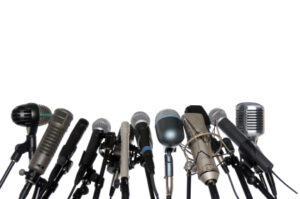 You have some important issues you want the public to know about. You are so concerned about it that you call a news conference.
You have some important issues you want the public to know about. You are so concerned about it that you call a news conference.
It wasn’t an easy decision. You don’t know which reporters will show up and their quick-fire questions can be intimidating. If you make one mistake, it will be captured on tape or in print. However, a news conference can have its advantages if you know how to maintain control.
The Set-Up
A news conference must be set-up so that you have control over what the media captures.
1) The table can be a barrier.
2) Sitting down can make you look too relaxed.
In order to grab your audience’s attention you have to look alert, excited and ready. Normally the best set-up is to stand, with the spokesperson in the middle. Instead of using a desk or a conference table, use a podium. It will also give the broadcast media a place to put their microphones within a reasonable distance from the spokesperson and still get good sound quality.
Strength in Numbers?
Most of the time, holding a news conference with more than one spokesperson can be tricky. There are several reasons for this. The more speakers, the less control you have over the information that appears on the six o’clock news. Remember, “control” is the key word. If you get five people in a room, and they all make the same point, they will make it in five different ways. That gives the reporter too much to decipher, which increases the chances of being misquoted or misinterpreted.
Speak To Humans
At a news conference, the spokesperson should know how to speak in human terms. Tell people how they will be affected. Proper training is usually necessary to keep professionals from speaking in their own jargon.
Use catchy phrases and give short answers. Most importantly, you have to show the public why your concerns should be their concerns. Just saying that the issue is important to you won’t win over your audience.
It’s also important to stay away from too many statistics while the camera rolls. Save the stats for the background information or wait until the reporter asks for them. Too many statistics on camera is a guaranteed yawn for your audience.
Before the media questions you, question yourself. Ask yourself what points you are trying to make and limit that to the three most important things. Then ask another question: Who is your audience? Address your answers to it, not the reporter.
Buzzwords
Sometimes reporters will put a “buzzword” in their question to get you to repeat it. Don’t fall into that trap. One reporter might ask you if the problem today is “overwhelming.” Their purpose might be to see if you would repeat the word and make it look as if the problems were too tough to handle. If the audience heard you say, “We don’t think it’s overwhelming,” they will really hear, “We think it’s overwhelming.” The answer should be positive, such as, “We obviously believe the problem can be solved and our suggestions will help do that.”
So You Think You Know It All?
During a news conference, while the cameras are rolling, a reporter might request some statistics. The exact figures weren’t known. The best thing to do is to tell the reporter that you will get the information after the news conference. Then make following-through a priority. The next time around, the reporter will rely on you as the expert for their story.
The worst thing you can do is to act like you know something when you don’t. You will be inviting trouble. Remember, videotape lasts for years; a reporter can use your misquote over and over.
This article, written by Al Rothstein, president of Al Rothstein Media Services, Inc. (http://www.rothsteinmedia.com), originally appeared in PR Fuel (https://www.ereleases.com/prfuel), a free weekly newsletter from eReleases (https://www.ereleases.com), the online leader in affordable press release distribution. To subscribe to PR Fuel, visit: https://www.ereleases.com/prfuel/subscribe/.
